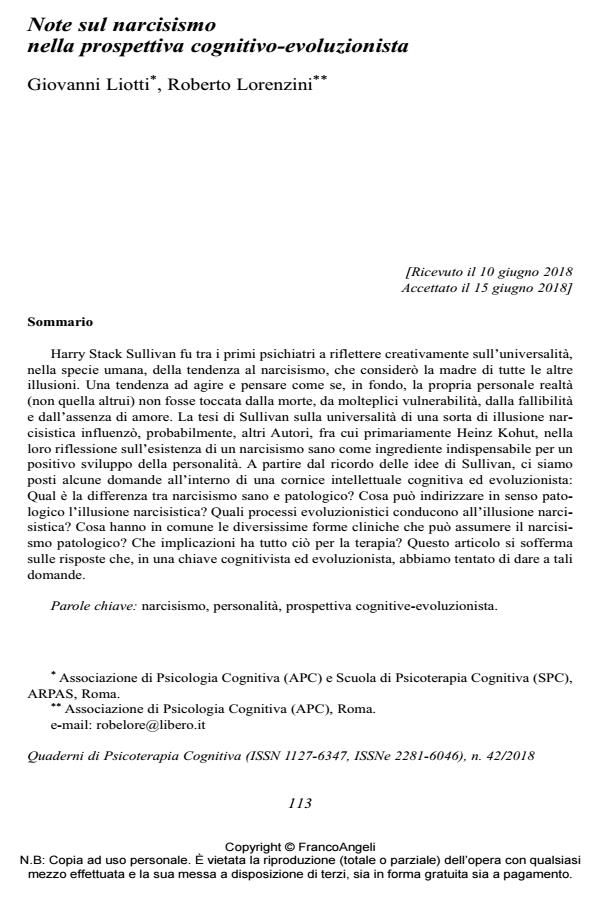Notes on narcissism in a cognitive-evolutionary perspective
Journal title QUADERNI DI PSICOTERAPIA COGNITIVA
Author/s Giovanni Liotti, Roberto Lorenzini
Publishing Year 2018 Issue 2018/42
Language Italian Pages 27 P. 113-139 File size 155 KB
DOI 10.3280/QPC2018-042008
DOI is like a bar code for intellectual property: to have more infomation
click here
Below, you can see the article first page
If you want to buy this article in PDF format, you can do it, following the instructions to buy download credits

FrancoAngeli is member of Publishers International Linking Association, Inc (PILA), a not-for-profit association which run the CrossRef service enabling links to and from online scholarly content.
Harry Stack Sullivan was one of the first psychiatrists to creatively reflect on the universal tendency to narcissism in the human species, which was considered to be the mother of all illusions. Atendency to act and think basically as if one’s own personal reality (and not other’s) was detached from death, from multiple vulnerabilities, from fallibility and from absence of love. Sullivan’s theory on the universality of a sort of narcissistic illusion probably influenced other Authors, among which Heinz Kohut, on their reflection on a healthy narcissism as indispensable ingredient for a positive development of personality. Starting from Sullivan’s ideas memory we asked ourselves some questions in a cognitive and evolutionary context: What is the difference between a healthy and a pathological narcissism? What can address the narcissistic illusion in a pathological sense? What evolutionary processes lead to the narcissistic illusion? What do the many different clinical types of pathological narcissism have in common? What are the implications of it for the therapy? This article focuses on the answers that, in a cognitive and evolutionary key, we tried to give to these questions.
Keywords: Narcissism, personality, cognitive-evolutionary perspective.
- L’impatto della pandemia sui comportamenti rischio dei giovani: le challenge rischiose Patrizio Pastore, Gerarda Grippo, in Community Notebook. People, Education and Welfare in the Society 5.0 6/2024 pp.259
DOI: 10.61007/QdC.2023.3.162
Giovanni Liotti, Roberto Lorenzini, Note sul narcisismo. nella prospettiva cognitivo-evoluzionista in "QUADERNI DI PSICOTERAPIA COGNITIVA" 42/2018, pp 113-139, DOI: 10.3280/QPC2018-042008